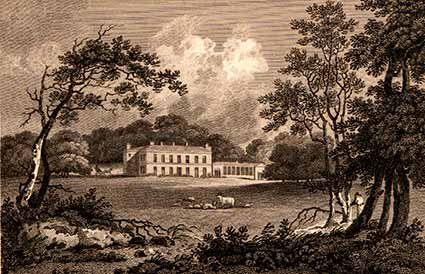Cuffnells – the early years

Cuffnells, or Cuffnalls as the name has alternatively been spelt, was for many years an extensive country estate of 160 acres on the outskirts of Lyndhurst. But the mansion house was demolished in the mid-20th century, and is recalled now by an 18th century lodge and driveway on the A35 Christchurch road; by Cuffnell’s Farm; and by the late-19th century Cuffnell Cottage close to the turning for Bank on the A35.
Bocus de Cuffenore - considered to be an earlier form of the name - was mentioned way back in 1375 when it was thought to refer to Cuffa’s bank or slope. Isaac Taylor on a 1759 map of the New Forest showed Cuffnells and a symbol denoting a large house, whilst Richardson, King and Driver in the late 18th century provided considerable detail of the estate boundaries, the location of the house and the layout of associated buildings.
As with many country estates, Cuffnells changed hands relatively frequently. In 1741, the year of construction of the Lyndhurst parish church that preceded the present building, church seating arrangements show ‘Mr. South of Cuffnells’. By 1783, the Rate Books show Sir Thomas Tancred, Bart, whose interests extended considerably beyond the New Forest – he was also Provincial Grand Master of the Masonic Province of Yorkshire, West Riding, between 1771 and 1779.
After Sir Thomas’ death in 1784, the estate was purchased by George Rose, who is shown as the owner on the Richardson, King and Driver map. Born at Brechin, Scotland, on June 11, 1744, Rose was the son of a poor clergyman. After a career in the Navy, talents as an administrator took Rose into public service where he became Joint-secretary to the Treasury and eventually President of the Board of Trade.
Rose was closely associated with William Pitt (the Younger), and was visited at Cuffnells by both the Prime Minister and King George III.
Remarkably, Rose also found time to be a New Forest Verderer, and MP for Lymington and Christchurch. He was also the owner of a racing bull that turned out at Lyndhurst Race Ground where, from all accounts, it performed admirably.
Rose was responsible for substantial alterations and additions to the old house. According to the Biographical Dictionary of Eminent Scotsmen, published in 1856: ‘He purchased the estate of Cuffnells, in the New Forest, which he spent a large sum in ornamenting. His regular and temperate life was prolonged to a greater extent, than might have been expected from the laborious way in which he had spent it. He died at Cuffnells on January 13, 1818, in the 75th year of his age. It was the singular fortune of Mr. Rose that he could declare in his last moments, in reference to his family, that they had been a blessing to him during the long series of years, and had never caused him one hour’s pain.’
William Cobbett, though, writing in Rural Rides, was not quite so generous when referring to George Rose.
This is from the commentary that accompanies the Penguin Classics edition of Rural Rides:
‘George Rose, 1744-1818 of Lyndhurst, Hants, MP from 1784, ‘Old George Rose’ figures often in Cobbett’s writing. His name was synonymous with corruption, places, pensions and sinecures. Rose held numerous paid offices (Cobbett kept a running total), and assisted Pitt in allocating pensions and finding bodies for offices. Cobbett represents him as a bemused, jovial figure.’
In the text of Rural Rides, Cobbett refers dismissively to Rose as ‘the Old Navy Purser, George Rose’. And again: ‘That impudent fellow, Old Rose…….. When men in power are ignorant to this extent, who is to expect anything but consequences such as we now behold?’
Then referring to Rose’s son, who for a while succeeded him at Cuffnells: ‘Sir George Henry Rose (1770-1855): son of ‘Old George Rose’ and MP for Southampton (1794–1813) and Christchurch (1818-44).’
Eight years after Rose’s death, on a visit to Lyndhurst in October 1826, Cobbett remarks: ‘I am here close by the Old Purser’s son, George Rose’s! (The exclamation mark is Cobbett’s).
In October 1826, Cobbett rages: ‘This Forest has been crawled upon by favourites, and is now much smaller than it used to be. A time may, and will, come for inquiring how George Rose, and others, became owners of some of the very best parts of this once-public property…..’
And so, singled out as the subject of some controversy, at least in the eyes of the incorrigible Cobbett, Cuffnells moved sedately through the early years of the 19th century.
Find out more about Cuffnells
References:
Lyndhurst Historical Society publications: Roy Jackman
Lyndhurst – A Brief History and Guide: Georgina Babey and Peter Roberts
Biographical Dictionary of Eminent Scotsmen
Rural Rides: William Cobbett
More links
Other related links
Search this site

Sadly, 58 animals were killed - 35 ponies, 13 cows, 8 donkeys and 2 sheep, whilst a further 32 were injured - 3 pigs, 9 donkeys, 11 cows and 9 ponies.
(Forty-three accidents occurred in daylight, 15 at twilight and 101 in the dark. Twenty-seven accidents were not reported by the driver involved).
Here's just one horrific example - Three donkeys killed in collision with van at notorious New Forest blackspot (Advertiser and Times)

